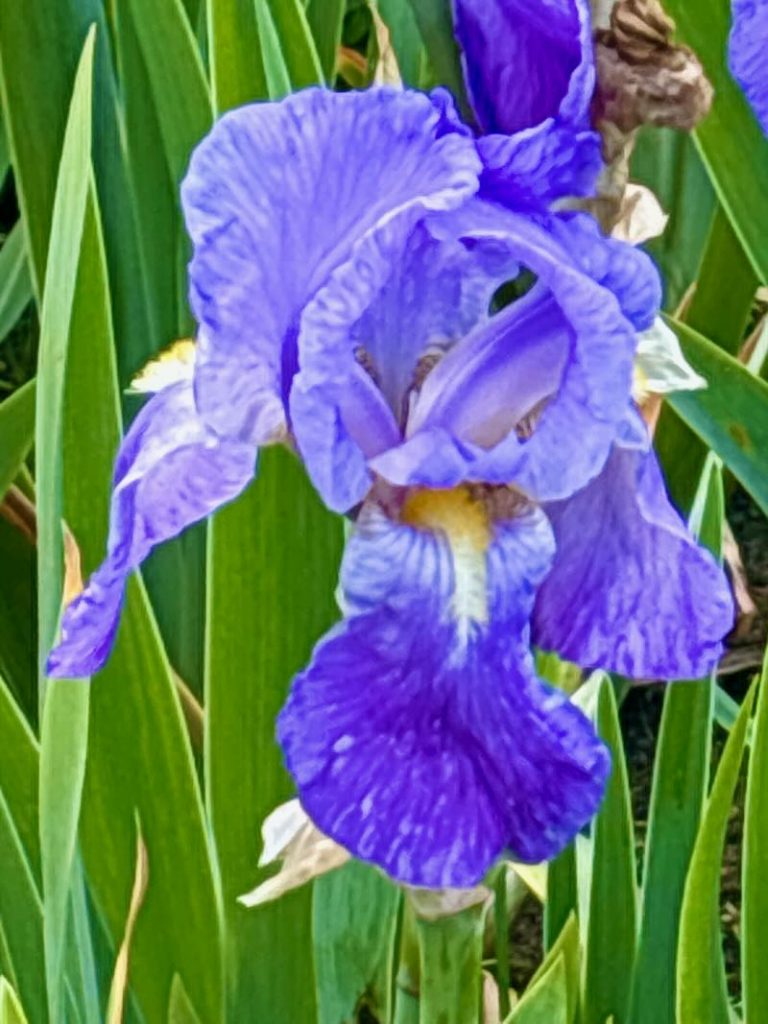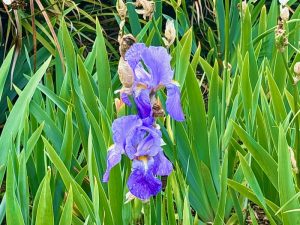Iris pallida: A Complete Guide to Growing the Dalmatian Iris
Iris pallida is a striking bearded iris valued for its fragrant flowers, bold foliage, and adaptability in the garden. Often referred to as the Sweet Iris or Dalmatian iris due to its origins in the Dalmatian region of Croatia, this perennial adds elegance and resilience to borders, cottage gardens, and naturalized spaces. Belonging to the family Iridaceae, Iris pallida is a versatile species that has been cultivated for centuries, not only for its beauty but also for its rhizomes, which are used to produce orris, a valuable ingredient in perfumery.
Description of Iris pallida
Iris pallida forms neat, clumping fans of bluish-green, sword-shaped leaves. They grow 40–50 cm (16–20 in) long and about 2.5–3 cm (1–1.2 in) wide. These upright leaves remain attractive throughout the growing season, and in milder climates, they may persist nearly evergreen through winter. In colder areas, the foliage dies back to the ground but re-emerges vigorously in spring.
In late spring to early summer, the plant produces tall, sparsely branched scapes reaching up to 100 cm (40 in) in height. Each stem carries two to three large, ruffled flowers, 7–12 cm (3–5 in) wide, in soft shades of pale lavender to whitish-blue. The name “pallida,” meaning “pale,” likely refers to this delicate flower coloring. The blooms feature yellow-tipped beards and a sweet, distinctive fragrance often described as reminiscent of orange blossom, vanilla, or even grape jelly. The papery white spathes surrounding the flower buds add to its refined appearance, making it a standout in any planting.
Native Habitat and Adaptability
Native to the Dalmatian coast, the southern Alps, and the Istrian Peninsula, Iris pallida thrives in rocky hillsides, limestone outcrops, and gorge edges. It adapts well to Mediterranean and sub-Mediterranean zones but can also grow successfully in temperate gardens far from its native range. In North America, it has naturalized in parts of California, Missouri, and Texas. This species performs well in both poor, rocky soils and fertile garden beds, provided it receives excellent drainage.
Iris pallida tolerates a range of conditions, from full sun to partial shade, making it more shade-tolerant than many other bearded irises. Once established, it withstands drought, though consistent moisture during its active growing season helps it achieve its best flowering. Its hardiness in USDA Zones 4–9 makes it suitable for a wide range of climates.
How to Grow Iris pallida
Light
Plant Iris pallida in full sun for optimal flowering. It can tolerate partial shade, especially in regions with hot summers, but at least six hours of direct sunlight each day encourages strong blooms and healthy foliage.
Soil
Well-drained soil is crucial. Plant it in loamy or sandy soil with a pH between 6.0 and 7.5. If your soil is heavy clay, amend it with compost, coarse sand, or other organic matter to improve drainage. Raised beds can be an excellent option in poorly drained areas.
Watering
Newly planted rhizomes require regular watering to establish strong roots. Once established, Iris pallida prefers deep but infrequent watering, allowing the soil to dry slightly between waterings. Reduce watering after blooming as the plant transitions into dormancy. Overwatering, especially in summer or winter, can lead to rhizome rot.
Fertilizing
Feed Iris pallida with a low-nitrogen fertilizer such as 5-10-10 or 6-10-10 in early spring when new growth emerges and again after flowering to replenish nutrients. Avoid fertilizers high in nitrogen, which encourage leaf growth at the expense of blooms and can increase the risk of rot.
Planting
Plant rhizomes from late summer to early fall, allowing them time to root before winter. Position the rhizome horizontally with its top slightly exposed or just covered with soil. In very hot or sandy areas, covering the rhizome with up to 2.5 cm (1 in) of soil can help protect it. Space rhizomes 30–60 cm (12–24 in) apart to ensure good air circulation, which helps prevent disease.
Pruning and Maintenance
Deadhead spent flower stalks by cutting them back to the base to direct the plant’s energy into its rhizomes rather than seed production. Allow healthy green foliage to remain after blooming so it can continue photosynthesis, providing energy for the next year’s flowers. In autumn, cut foliage back to 10–15 cm (4–6 in) after the first frost or when it begins to yellow naturally. This seasonal cleanup reduces overwintering pests and diseases.
Dividing Iris pallida
Divide clumps every three to four years or when flowering declines. Overcrowded plants produce fewer blooms and are more susceptible to pests and disease. The best time to divide is in late summer or early fall, roughly six to eight weeks after blooming. Dig up the clump, wash off soil, and cut away old, soft, or diseased rhizomes. Replant healthy sections with at least one fan of leaves, trimming foliage back to about 15 cm (6 in).
Pests and Diseases
Iris pallida is relatively hardy but can suffer from common iris pests and diseases if neglected.
- Iris borer: Watch for vertical streaks in leaves, a sign of iris borers tunneling into rhizomes. Remove and destroy affected foliage and rhizomes.
- Bacterial soft rot: Prevent by ensuring proper drainage and avoiding overwatering. Remove and discard any rotting rhizomes.
- Slugs and snails: Use traps or bait to control these pests, especially in moist, shaded areas.
- Aphids: These pests can transmit viral diseases; wash them off with water or treat with insecticidal soap.Good garden hygiene, including removing dead foliage and debris, significantly reduces the risk of pest and disease problems.
Uses of Iris pallida
Beyond its ornamental value, Iris pallida is cultivated for its rhizomes, which are processed into orris root. Orris root has been used for centuries as a fragrance fixative in perfumery and as a flavoring in spirits and breath fresheners. In medieval times, it was valued for its supposed medicinal and magical properties. This dual purpose makes Iris pallida not only a garden favorite but also a plant of cultural and historical importance.
Variegated Forms of Iris pallida
While this article focuses on the non-variegated Iris pallida, there are also variegated forms, such as Iris pallida‘Variegata’, prized for their striking cream-striped foliage. These cultivars offer visual interest even when not in bloom and make excellent choices for ornamental plantings. If you’re interested in learning more about variegated varieties, see our detailed article on variegated Iris pallida selections.
Conclusion
Iris pallida is an exceptional perennial for gardeners seeking beauty, fragrance, and resilience. Its bluish-green foliage, fragrant pale blooms, and low-maintenance nature make it an ideal choice for borders, cottage gardens, and naturalized plantings. With proper care—well-drained soil, full sun, and periodic division—this iris rewards gardeners with years of reliable performance. Whether grown for its ornamental charm or its historic use in perfumery, Iris pallida is a plant that brings both elegance and heritage to the garden.



